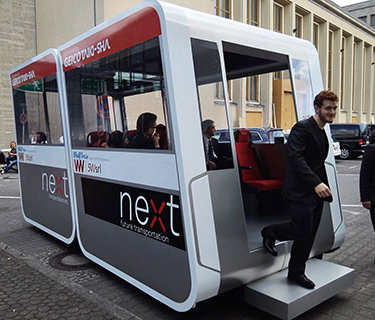|
Subscribe / Renew |
|
|
Contact Us |
|
| ► Subscribe to our Free Weekly Newsletter | |
| home | Welcome, sign in or click here to subscribe. | login |
Real Estate
| |
 |
June 22, 2017
Ready for a revolution in urban transportation?
DKS Associates

Usen
|
Imagine if your typical Seattle morning commute began with summoning an affordable ride share service through an app. Rather than walking or driving to a bus stop, you wait outside your home to be picked up by a driverless shuttle with algorithms that have optimized your trajectory and that of the dozen or so passengers already inside.
Some personal autonomous vehicles on the road this morning have traditional front-facing seats, but many have seats facing inward to a common area where parents are serving breakfast on the way to school and commuters are starting their work day. Some passengers appear to be sleeping. Nearly all the vehicles on the road, for both passengers and freight, are electric and driverless, sporting the logos of the companies that operate them.
Traffic is heavy, but your ride breezes through intersections that have been optimized with signal prioritization, programmed to collect data from current traffic conditions. You’re dropped off at a multimodal hub, where a line of autonomous shuttles, cars, and buses are lined up at the curb to drop off and pick up passengers. Commuters stream out to the bike share station to hop on electric bikes for the last leg of their trip. Your whole commute, which in 2017 might have taken 50 minutes via bus, is now closer to 20. And it costs half of what it would have in 2017, while consuming a lower carbon footprint.
Changing transportation
This futuristic vision could be Seattle in as little as 13 years according to “Three Revolutions in Urban Transportation,” a fascinating new report published last month by the Institute for Transportation & Development Policy and University of California, Davis.
The article posits that we are on the cusp of three game changers — vehicle electrification, automation and shared vehicle usage — that will revolutionize transportation. How these revolutions play out depends on our commitment to policies that support a changing transportation network.
Without this commitment, the report warns of an alternate future characterized by significantly worse congestion, urban sprawl, and an expanded carbon footprint. Will the convenience and low cost of automated Ubers and Lyfts seduce riders off public transit and encourage exurban growth? Could thousands of empty, driverless vehicles en-route to their next pickup make congestion worse?
Looking to the future
Such concerns about mobility are shared by local public agencies.
Carol Cooper, who supervises King County Metro Transit’s Market Development group, says: “King County, SDOT and Sound Transit have been working closely on these issues to have a coordinated approach. Autonomous vehicles (AVs) will certainly be beneficial in various ways but we are currently focused on the competing demands on right-of-way and curb space and how AVs will change those dynamics. How AVs will interface with transit is something we need to be proactive about and we are exploring innovative new approaches to encourage shared mobility.”
Along with mobility, parking will also be impacted by these looming changes. The demand for parking is expected to decline radically with the rise of autonomous vehicles, and we need to start planning for that future now.
Daniel Rowe, who oversees King County Metro’s access to transit program, understands these future challenges. King County Metro’s new long-range plan proposes adding 3,300 permanent parking stalls, but Rowe explains that, “for major capital investments in parking, we need to ensure that investments are adaptive to allow for changes in mobility patterns, such as lower demand for long-term parking and potential to convert parking to other uses such as affordable housing. We are going to need help from the architecture community to design parking to accommodate future needs.”
As a national director for Smart Cities and Connected Vehicles at the transportation planning and engineering firm DKS Associates, Adrian Pearmine is often at the forefront of these issues. He advises state and local governments one day and collaborates with connected vehicle technology pioneers the next.
Pearmine advocates for a future that is guided by carefully developed plans and regulations, not left to chance or to the technology and transportation industries. “There is too much at stake,” Pearmine says. “In the short term, it’s public safety and equity. In the long run, it’s all of the issues that are discussed in the UC Davis study.”
In an ideal world, Pearmine says, “the combination of technology, business models, and the appropriately applied blend of policy and regulation has the potential to make transformational change. And not just in transportation, but across all sectors of society and city design.”
Mobility as a service
As the fastest growing large city in the U.S., Seattle must accommodate a 40 percent increase in total daily person trips forecasted by 2040.
Evan Corey from Seattle Department of Transportation acknowledges that the city will need to explore new avenues.
“Although the agency has invested heavily in public transit, SDOT and our public transit partners also acknowledge the benefits and risks that new, shared mobility services and emerging transportation technologies may bring,” Corey says. “App-enabled transportation lets consumers better understand their transportation options, book and pay for trips, and receive incentives for using shared transportation modes. We are working to test new avenues for Seattleites to consume mobility as a service and enhance their experience while moving throughout the city.”
High-capacity transit, walkable neighborhoods and bikeable streets are the bedrock of Seattle’s transportation system. Even so, the city is facing questions about the future. How do we legislate for these changes? How do we plan for a city with streets that operate very differently than they do today? Each of these questions leads directly to a new set of questions.
The changes to our streets may be as transformative as the invention of the horseless carriage at the beginning of the 20th century, and questions won’t be answered by just one industry. Transportation planners and engineers, agencies, policymakers, technology companies, vehicle manufacturers, and even hardware firms will need to work together to be sure we face a future that is a commuter’s dream rather than a dystopian streetscape.
Mike Usen, AICP, is a senior transportation planner at DKS Associates in Seattle. His practice focuses on helping the rapidly evolving transportation industry facilitate a carbon-free shared mobility transportation future.
Other Stories:
- New towers create a construction tango in downtown Seattle
- Renters seek buildings that reflect their lifestyles
- Affordable housing gets a boost from impact investors
- Bremerton’s triple treat: affordability, nature, life balance
- When it comes to apartments, one size doesn’t fit all
- Unused building? Consider housing homeless families there
- Westbank tees up 3 big projects in Seattle
- Buildings soar skyward as modular frame systems evolve
- Don’t question the value of green design — bank on it



